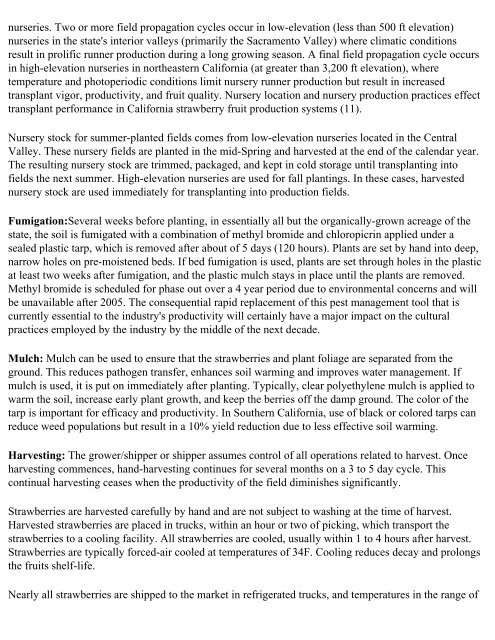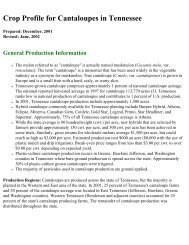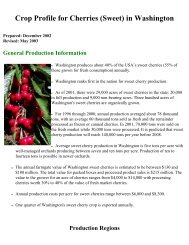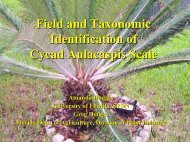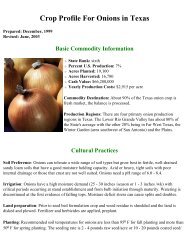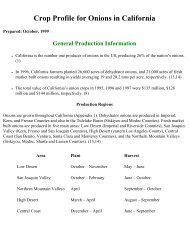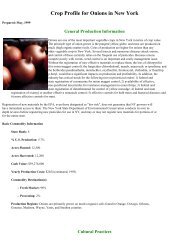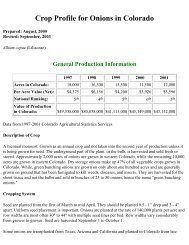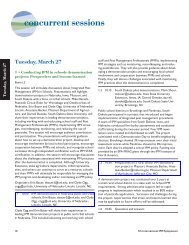Crop Profile for Strawberries in California - Regional IPM Centers
Crop Profile for Strawberries in California - Regional IPM Centers
Crop Profile for Strawberries in California - Regional IPM Centers
You also want an ePaper? Increase the reach of your titles
YUMPU automatically turns print PDFs into web optimized ePapers that Google loves.
nurseries. Two or more field propagation cycles occur <strong>in</strong> low-elevation (less than 500 ft elevation)<br />
nurseries <strong>in</strong> the state's <strong>in</strong>terior valleys (primarily the Sacramento Valley) where climatic conditions<br />
result <strong>in</strong> prolific runner production dur<strong>in</strong>g a long grow<strong>in</strong>g season. A f<strong>in</strong>al field propagation cycle occurs<br />
<strong>in</strong> high-elevation nurseries <strong>in</strong> northeastern Cali<strong>for</strong>nia (at greater than 3,200 ft elevation), where<br />
temperature and photoperiodic conditions limit nursery runner production but result <strong>in</strong> <strong>in</strong>creased<br />
transplant vigor, productivity, and fruit quality. Nursery location and nursery production practices effect<br />
transplant per<strong>for</strong>mance <strong>in</strong> Cali<strong>for</strong>nia strawberry fruit production systems (11).<br />
Nursery stock <strong>for</strong> summer-planted fields comes from low-elevation nurseries located <strong>in</strong> the Central<br />
Valley. These nursery fields are planted <strong>in</strong> the mid-Spr<strong>in</strong>g and harvested at the end of the calendar year.<br />
The result<strong>in</strong>g nursery stock are trimmed, packaged, and kept <strong>in</strong> cold storage until transplant<strong>in</strong>g <strong>in</strong>to<br />
fields the next summer. High-elevation nurseries are used <strong>for</strong> fall plant<strong>in</strong>gs. In these cases, harvested<br />
nursery stock are used immediately <strong>for</strong> transplant<strong>in</strong>g <strong>in</strong>to production fields.<br />
Fumigation:Several weeks be<strong>for</strong>e plant<strong>in</strong>g, <strong>in</strong> essentially all but the organically-grown acreage of the<br />
state, the soil is fumigated with a comb<strong>in</strong>ation of methyl bromide and chloropicr<strong>in</strong> applied under a<br />
sealed plastic tarp, which is removed after about of 5 days (120 hours). Plants are set by hand <strong>in</strong>to deep,<br />
narrow holes on pre-moistened beds. If bed fumigation is used, plants are set through holes <strong>in</strong> the plastic<br />
at least two weeks after fumigation, and the plastic mulch stays <strong>in</strong> place until the plants are removed.<br />
Methyl bromide is scheduled <strong>for</strong> phase out over a 4 year period due to environmental concerns and will<br />
be unavailable after 2005. The consequential rapid replacement of this pest management tool that is<br />
currently essential to the <strong>in</strong>dustry's productivity will certa<strong>in</strong>ly have a major impact on the cultural<br />
practices employed by the <strong>in</strong>dustry by the middle of the next decade.<br />
Mulch: Mulch can be used to ensure that the strawberries and plant foliage are separated from the<br />
ground. This reduces pathogen transfer, enhances soil warm<strong>in</strong>g and improves water management. If<br />
mulch is used, it is put on immediately after plant<strong>in</strong>g. Typically, clear polyethylene mulch is applied to<br />
warm the soil, <strong>in</strong>crease early plant growth, and keep the berries off the damp ground. The color of the<br />
tarp is important <strong>for</strong> efficacy and productivity. In Southern Cali<strong>for</strong>nia, use of black or colored tarps can<br />
reduce weed populations but result <strong>in</strong> a 10% yield reduction due to less effective soil warm<strong>in</strong>g.<br />
Harvest<strong>in</strong>g: The grower/shipper or shipper assumes control of all operations related to harvest. Once<br />
harvest<strong>in</strong>g commences, hand-harvest<strong>in</strong>g cont<strong>in</strong>ues <strong>for</strong> several months on a 3 to 5 day cycle. This<br />
cont<strong>in</strong>ual harvest<strong>in</strong>g ceases when the productivity of the field dim<strong>in</strong>ishes significantly.<br />
<strong>Strawberries</strong> are harvested carefully by hand and are not subject to wash<strong>in</strong>g at the time of harvest.<br />
Harvested strawberries are placed <strong>in</strong> trucks, with<strong>in</strong> an hour or two of pick<strong>in</strong>g, which transport the<br />
strawberries to a cool<strong>in</strong>g facility. All strawberries are cooled, usually with<strong>in</strong> 1 to 4 hours after harvest.<br />
<strong>Strawberries</strong> are typically <strong>for</strong>ced-air cooled at temperatures of 34F. Cool<strong>in</strong>g reduces decay and prolongs<br />
the fruits shelf-life.<br />
Nearly all strawberries are shipped to the market <strong>in</strong> refrigerated trucks, and temperatures <strong>in</strong> the range of


